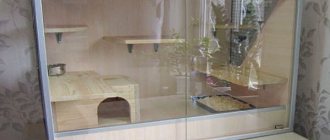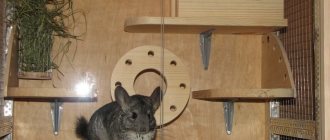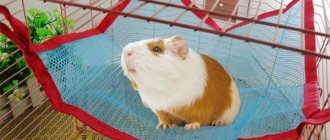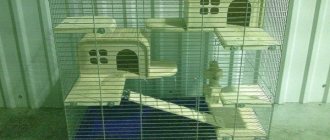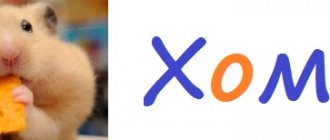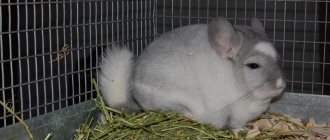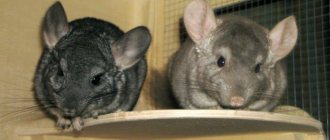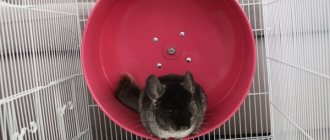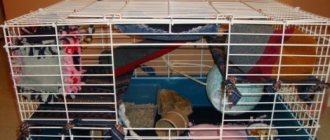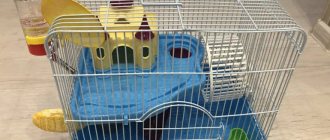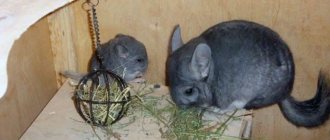Why a showcase?
The most suitable housing option for a rodent would be a display case. It must be completely closed, this is necessary for the animal to feel comfortable and protected. The main difference between this type of housing and a cage is the ability to use various types of materials when making it yourself.
The best material, of course, will be wood, since this material is environmentally friendly for the animal. But the material also has disadvantages: wood absorbs moisture and odors that come from the animal very well. In addition to this material, fiberboard, chipboard, and aluminum profiles are used. The aluminum profile option will be the most convenient and durable, but its cost will also be higher than other options.
Advantages of the showcase:
- The area around the animal’s house will always be clean, as no debris will spill through the bars.
- Cleaning is quick and easy.
- There is much less noise from an animal that lives in a window.
- The pet will not chew metal rods that are painted.
- By making a contraction according to your own drawings, you can make the display case an element of the room’s design.
- By screwing the wheels to the bottom of the display case, it can be easily moved from place to place.
This housing option is very convenient and this will become immediately clear as soon as the animal is moved into it.
Prevention and care of display cases
Every day you need to wash the feeder, drinking bowl and tray. If litter is used for the toilet, it is changed as it gets dirty. The entire display case is cleaned at least once a week. Before this, the chinchilla is carefully removed from the home. Afterwards, all objects are pulled out of it. It is more convenient to get rid of garbage using a vacuum cleaner. To wash glass, you need to prepare a soda solution. Do not use a hard sponge; it will leave scratches. The floor is thoroughly wiped and dried. The side walls are cleaned of dust with a damp cloth. The attributes are washed and dried, only then put back in their places. It is advisable to disinfect the pet’s home using a special product. You can buy it at your local pet store.
Such a fluffy creature like a chinchilla requires the right approach to choosing a home. Instead of a rodent cage, it is better to buy a display case. It meets all stated requirements. In the absence of funds, such a design can be made with your own hands from available materials.
Source
Step-by-step manufacturing instructions
Showcase drawing To make a display case for a chinchilla yourself, you first need to draw up a drawing.
An interesting suitable option can be found on the Internet - when using, substitute your dimensions to see if you can make the model you like. If you do not have sufficient experience in construction work, it is better to take a simpler drawing, as in this photo: After all the measurements have been taken and transferred to the diagram, all drawings are made on paper on a reduced scale. At this stage it is important to carefully check that all dimensions are correct.
Then, using a ruler, marker or chalk, the details of the drawing are transferred to life-size pieces of wood or chipboard. Next, the following steps are performed:
- The parts of the rack are cut out from the prepared materials using a hacksaw or electric jigsaw exactly in accordance with the diagram. For metal, a grinder and appropriate cutting wheels are used. If home conditions do not allow you to work with parts, or there are no suitable tools, you can contact a workshop. Such a service will not be free, but still will not require large expenses.
- Windows are cut out in the side walls for ventilation and covered with mesh. Pieces of mesh are cut using metal scissors and then attached with wide-headed screws. To disguise and protect the mounting points, you can use metal profile thresholds.
Windows for ventilation are covered with mesh - Ventilation holes are also often made in the ceiling - you can cover it entirely with a mesh. It will be convenient to attach fastenings for hanging toys and hammocks to the metal mesh cells.
- In the marked places, drill holes for the tie screws. Their task will be to fasten the parts together.
- First, the rear and side walls are attached to the pallet, then the ceiling is installed using the same principle.
- Install fastenings for shelves and the shelves themselves.
- Screw the door hinges holding the glass facade.
- In places where chipboard cuts are visible, glue PVC tape.
- To protect pets from drafts, the display case must be raised to a height of 30-50cm. For this purpose, you can cut out wooden legs, but it is better to make a bedside table. Then this space under the shelving can be used to store food, sand, bathing suits, toys and other accessories for keeping animals.
- In order to assemble the bedside table, screws and self-tapping screws are used, the hinged door is attached to furniture hinges , and special magnetic fittings can be used as a lock.
Popular cell types
Sand for its composition, special attention is paid to it, since the beauty of the fur skin depends on it. The animals perform hygienic procedures in sand, while the use of river sand, as well as quartz sand, is excluded. With sharp fragments, the material does not clean the fur, but spoils and cuts the hair.
Breeders began to use a composition made from volcanic dust. It provides excellent cleaning with good moisture absorption. It is believed that the animals behaved this way in their natural environment, and bathed in this substance.
You can check the quality of dust content in the package only after opening it; the color of the composition should be matte; any shine indicates foreign particles. If you rub them in your hands, there should be a trace left on them, like powder, when poured with liquid, the real dust will dissolve, and the heavy quartz will settle to the bottom of the container. Before arranging a swim, you need to resolve the issue of housing. Home cages are somewhat different from professional cages.
The following designs were included in the review, the most popular among breeders:
- Houses connected with metal rods. Similar options are presented by sales representatives; they are easy to build yourself. The advantage of such buildings is their low cost and ease of installation.
- Manufacturers, in general, completely supply all the necessary parts; it will not be difficult for the owner to assemble the elements and not worry about further arrangement.
- Dwellings presented as a kind of showcase will be needed by those who decide to start a family of chinchillas. In this constructive space there are all the details necessary for future offspring. The material chosen is different, but suitable both for interior decoration, where wood is preferred, and for external structures made of metal elements.
A thrifty owner is not prohibited from starting construction on his own, using improvised products that have fallen out of use among household members. The best solution would be to first display the building plan on paper. The drawing will allow you to calculate all the necessary parts by size and quantity. A display-type dwelling can be built from old furniture; cabinets and chests of drawers are suitable for various configurations.
Chinchillas have become a profitable business because of their fur. For commercial breeding, cages of other sizes and designs are needed, designed for the constant reproduction of individuals.
Breeders take into account the number of females required for one male for effective productivity.
A male can serve up to 8 chinchillas, but the owner tries to keep a good sire and prefers to give him no more than 4 future mothers. The cells are arranged in cells arranged on floors, where each is intended for one family. The uteri are separated from each other by their own space, but the rodent moves freely between them through a special passage built into each combined cell wall.
Features of creating a design
- First of all, a do-it-yourself chinchilla display window should be at least eighty centimeters high.
- Many also leave space below for food, nutritional supplements and a variety of toys. To do this, you will need a space of at least another thirty centimeters.
- When creating a drawing of a future structure, special attention should be paid to the appearance. The house must fit completely into the existing interior.
- You also need to clearly calculate the dimensions of the cabinet that will be located under the display case. The average size is considered to be one hundred and forty centimeters, taking into account the experience of other owners of such interesting animals.
- Depth is also given a special place. It must be at least thirty centimeters. It will be convenient for the animal to run around in such a cage, and such dimensions fit quite well into the existing interior of an apartment or house.
- If we talk about width, then in this case there are no special restrictions. The only condition is that the minimum must be thirty centimeters. If the cage is narrower, the chinchilla simply will not be able to stay in it.
Homemade cage from old furniture
A lightweight option for making a display case at home can be to re-equip an unnecessary bookcase or kitchen cabinet. This will allow you to get by with a minimum set of materials and tools. Such a piece of furniture usually already has glass doors, so all that remains is to cut windows for ventilation and cover them with mesh, as well as make a division into floors. If the cabinet doors are solid, they are removed and replaced with glass ones; later, shelves can be cut out of wooden facades.
This is how you can convert an old cabinet into a display case
If the option with a display case does not suit you, you can make a cage with your own hands. To do this, we recommend reading the article “Do-it-yourself chinchilla cage.”
Requirements for the showcase
The minimum size of an enclosure for one animal should be 80x80x50 cm. If you plan to keep two pets, then, accordingly, the area should be doubled.
The display case should be made of durable and environmentally friendly materials, since the rodent will probably want to try it on its teeth.
Also among the requirements for a showcase, you should pay attention to the following:
- dryness;
- warm;
- cosiness;
- sufficient lighting;
- good ventilation.
Important! Keeping a chinchilla in cramped conditions and in violation of the above requirements will lead to the animal getting sick often.
The minimum set of items that are vital for a pet is a feeder, a drinking bowl, and a tray.
For a more comfortable pastime, you will also need a sleeping area closed from prying eyes, a hay feeder, play complexes, and other devices for relaxation and physical activity. We will talk about them in more detail in a separate section below.
How to set up a display case for a chinchilla
For the comfort of the animal, you should make sure that in the enclosure, in addition to the mandatory attributes - feeder, hay feeder (hay bowl), drinking bowl and toilet, there are items and accessories for its proper rest and wakefulness.
- Holiday house . Its purpose is to seclude the animal from prying eyes. The house should be somewhat larger than a chinchilla. She can be in it, stretched out to her full height. The house is made of wood. It can also be purchased ready-made at a pet store.
- Shelves . If your display case does not have a large area and it is impossible to install a house in it, then you should take care of arranging wooden shelves on which the pet will rest. They should be located low from the floor so that if the animal falls, it will not be injured.
- Hammock . Chinchillas love hammocks. They use them for both relaxation and entertainment. Hammocks can be of different designs, single-tiered and multi-tiered, from different materials and fabrics. They can be purchased, but most often owners make them with their own hands. However, be prepared that rodents quite often damage hammocks with their teeth.
- Toys . Like any creature, the chinchilla loves to play. Therefore, if the size of the display case allows it, you should take care of purchasing gaming complexes: tunnels, a running wheel, toys made of wood, branches, stumps.
- Sand bath . As you know, chinchillas love to bathe in sand, so you will give your pet great pleasure if you find a place in the display case for a sand bath.
Video: how to set up a display case for a chinchilla Items that should also be in the cage include a mineral or salt stone - for grinding teeth.
Also find out how to choose and arrange a home for a guinea pig and a hamster, and why you need a walking ball for a hamster.
How to make it yourself?
If you do not have a suitable cabinet for retrofitting, you can make your own cabinet. To ensure the most comfortable working conditions, you will need to use:
- using a screwdriver;
- with self-tapping screws of various sizes;
- with a jigsaw;
- new door hinges;
- with drill;
- with drill/bag;
- with sealing tape.
Since it is difficult to guess the dimensions, there are no ready-made drawings “for all occasions”. - you will have to make them yourself by measuring the allocated area of the room. Therefore, the appropriate amount of material is selected. This could be a rough sketch for a medium sized room.
Typically, supports are used as legs when the display floor is made of mesh and some clearance is needed between the mesh and the floor to allow a chinchilla waste collection container to be placed under the mesh.
In addition to simple shelves with holes, the chinchilla display case can be equipped with additional accessories. For example, a small house that can be easily made depending on the size of the storefront can serve as a shelter from daylight.
It should not be too big or too tight.
The feeder can be made in the form of a nursery made of wood or the same metal mesh into which hay or other food will need to be placed.
If a chinchilla is limited in physical activity, it will quickly gain weight. Therefore it is good to have a so-called city. It must consist of at least:
- treadmill;
- The shelves are on different levels and are connected by bridges, tunnels or stairs;
- swing/hammock.
Advantages of a display case for chinchillas
The main advantages of chinchilla display cases include:
- saving space. These structures are often placed along a wall, opening up a lot of space for mobile play, but take up less space than cages;
- Aesthetics. Such designs have a neat appearance and fit harmoniously into the space around them;
- opportunity to watch animals. In such designs, the facades are made of transparent glass, which makes them convenient for observation;
- low noise level. Unlike a cage, cages are more enclosed and do not have metal bars that animals like to chew on;
- Large interior space to accommodate numerous shelves, racks, ladders and other rodent toys;
- No trash and quick cleaning. Unlike an open cage, there will be no food, hay, or other trash that animals often throw out scattered around the cage.
Showcases must be a certain size
What materials can you use to make a display case for a chinchilla with your own hands?
You can make a chinchilla with your own hands from various materials:
- natural wood. This is the safest and most reliable option. The advantages of wood are environmental friendliness, aesthetics and resistance to negative factors. And to the disadvantages should be added: absorption of unpleasant odors, expensive costs, difficulty in operation;
- LDPE. The simplest and cheapest option. LDF is available in a wide range of colors, textures and structures. The material is easy to work with and can be used for the construction of structures of any complexity. One of the disadvantages is that it contains harmful substances. If an animal chews on the material, it can be poisoned;
- plexiglass. This option will prevent the absorption of foreign odors, will be characterized by easy cleaning, transparency and a beautiful appearance. Such designs will harmoniously fit into the modern style and become its main decoration. As for the disadvantages, it is the difficulty of cleaning. The glass will have to be constantly wiped with window cleaner and stains removed. In addition, this material scratches quickly and can cause cloudy stains;
- from an old closet. The easiest option. Old furniture can be easily and quickly turned into a fairly convenient and comfortable home for rodents. In this case, you will spend a minimum of free time, materials and finances. As a rule, the entire process of creating an apartment for rodents from an old wardrobe consists of making special ventilation holes and dividing the apartment into separate floors.
Materials and tools
Before you make a display case at home, you need to decide on the material for its manufacture. To solve the problem of teeth grinding, it is better to choose a natural material. The tree is safe for your pet's health. However, the overall cost will be significant. You can use laminated chipboard - high quality and inexpensive. It is ideal for the construction of such a structure.
From scratch
The first step is to decide where to place the finished display case. To do this, make a sketch indicating the parameters of the future design. You can see what it looks like on the Internet. Then you need to buy the necessary materials at the nearest hardware store. Laminated chipboard is considered an inexpensive material for making a rodent's home. Organic glass or metal mesh are also used. Before construction, a complete drawing should be drawn indicating the exact values of each component. Minimum size 80x80x50 cm.
What is a showcase for?
A display case for chinchillas is essential for a comfortable and fun life. Animals feel uncomfortable in cramped enclosures. For protection and maximum comfort, the chinchilla display case should be closed. In its manufacture, various materials can be used (chipboard, natural solid wood, plexiglass).
Naturally, natural wood is considered the best material. It is safe, does not release toxins and is durable. But at the same time, wood absorbs odors and deteriorates due to high humidity. Products made from chipboard and aluminum profiles are considered a good choice. They are more practical, durable and resistant to negative factors.
Important: veterinarians recommend keeping mobile chinchillas in tall buildings with numerous shelves and stairs. It is also necessary to place wooden objects in their home so that the animals can sharpen their teeth on them.
Advantages of a display case for chinchillas
The main advantages of chinchilla display cases include:
- saving free space. These structures are often placed along a wall, opening up plenty of space for outdoor play but taking up less space than cages;
- aesthetics. Such structures have a neat appearance and fit harmoniously into the environment;
- opportunity to watch animals. In such structures, the facades are made of transparent glass, so it is convenient to observe them;
- low noise level. Unlike a cage, the windows are more closed and there are no metal bars that animals love to chew;
- large internal space for placing many shelves, racks, ladders and other toys for rodents;
- lack of debris and cleaning efficiency. Unlike an open cage, food, hay and other trash that animals often scatter around will not be scattered around the display.
Requirements for the showcase
There are requirements for arranging housing for animals. The dimensions of the display case must be no less than:
- length - 80 cm;
- height - 50 cm;
- width - 80 cm.
An animal will fit comfortably in such an area. If you plan to keep two rodents, the area will need to be almost doubled.
Since chinchillas are rodents and tend to taste everything, their home should be made of environmentally friendly and safe materials. An excellent option would be to use natural wood. In addition, when maintaining them, it is worth taking into account temperature and humidity. To ensure that the housing is well illuminated, special lamps are used.
Warning: Before placing an animal in a new home, it is necessary to carefully inspect it for any sharp edges, otherwise the animal may be injured.
Before placing an animal in a house, it must be equipped with toys, a drinking bowl, feeders, a hay barn, game simulators and a sleeping area.
Main types of cells
Cellular structures come in different types. To choose the right one, you need to know their advantages and disadvantages.
Ordinary cell
Standard cages can be found at any pet store. An ordinary cage for a chinchilla costs on average from one and a half to five thousand rubles. There are also more expensive ones, depending on quality and size.
- You can choose by price, color, size.
- Easy to disassemble and move to another location.
- All amenities to maintain hygiene.
- Poor sound insulation, given that chinchillas are nocturnal.
- The rest of the hay, corn husks and stuffing are scattered around the room.
- The plastic parts of the cage are not durable.
Sometimes another drawback appears - the dimensions of the cage cannot always fit inside the room.
Wooden showcase
The showcase is usually made independently from scrap materials or made from plywood, furniture chipboard, or wood.
- You can use your unnecessary wardrobe as a basis for free;
- excellent sound insulation if the walls are wooden;
- place for an animal, you can raise a family;
- the ability to adapt the design to the interior of the apartment.
- difficult to disinfect;
- If cleaning is not done properly, a smell may appear;
- non-demountable design;
- short service life.
The last drawback can be eliminated if the display case is made of high-quality durable materials.
Professional showcase
An option for a durable product is a model made of aluminum, wood, chipboard, or glass. Such designs are used by professional breeders.
How to make it yourself?
If there is no furniture suitable for transformation, you can make a display case yourself. To ensure the most comfortable working conditions, you will need:
- screwdriver;
- self-tapping screws of different sizes;
- puzzle;
- new door hinges;
- drill;
- drill/swing;
- packing tape.
Since it is difficult to guess with dimensions, there are no ready-made drawings “for all occasions” - you will have to make them yourself, measuring the allotted area of the room. As a result, the required amount of material is also selected. This could be a rough sketch for a medium sized room.
Typically the posts are used as legs if the floor of the display case is made of mesh and some space is required between the mesh and the floor to allow for a waste container to be included under the chinchilla mesh.
In addition to simple perforated shelves, the chinchilla display cabinet is also equipped with some accessories. For example, a small house can serve as a pit, that is, a shelter from daylight, which is easy to make based on the size of the display case itself.
It shouldn't be too big or too narrow.
The feeder can be made in the form of a wooden feeder or the same wire mesh, where you will have to put hay or other food.
If your chinchilla is limited in physical activity, it will quickly gain weight. Therefore, the so-called city will be very appropriate. It must at a minimum consist of:
- racing steering wheel;
- multi-level racks connected by transitions in the form of a suspension bridge, tunnel or staircase;
- swing/hammock.
Where does the rodent live?
Through experience, experts came to the conclusion that a special display cage would be the optimal habitat for this rodent. Such display cases can be found in specialized stores, but if a person who wants to have a chinchilla in the house has certain plumbing and carpentry skills, he can save a lot of money by making this place for the future pet to live with his own hands. Let's try to figure out what a showcase is and how it differs from an ordinary cage?
Imagine your grandmother's sideboard, or rather, the upper part of it. This is a cabinet with doors at the bottom and glass shelves at the top, again behind glass doors that can be made sliding or opening. This upper part is the showcase. For a chinchilla, the shelves can be made of plywood, and the glass doors can be replaced with fiberglass material or something similar - as long as light penetrates.
It must be said that a chinchilla will feel much more comfortable in a display case than in a cage, and there are many reasons for this.
Having come to the conclusion that a showcase will be the most convenient habitat for a chinchilla, you need to pay attention that you can make a showcase yourself from wood, aluminum profiles, and plastic structures. There is a certain set of requirements for the manufacture of display cases:
It is not recommended to keep a chinchilla without enough space for physical activity, as this can certainly cause diseases.
This is one of the most important requirements for display cases of this type, so that the animal does not feel cramped. Chinchillas require at least 0.4 m2 per individual. Moreover, this area does not depend on the length or width of the display case - both can be changed either at will or based on the dimensions of the apartment.
For this reason, it is recommended to choose a cabinet made from natural wood rather than chipboard.
Here's a rough step-by-step process guide describing how to build a cabinet display.
Pros and cons of products
We have already looked at the main types of cells. Each has its own advantages and disadvantages for the breeder and the animal. Let us consider separately the pros and cons for all types of cells. They will come in handy when choosing between a homemade and purchased option, plus when selecting a suitable cage model in a store.
Metal cage
Among the advantages of this choice, we have already noted affordable prices with the house included in the kit. What else relates to the positive features of metal cages:
However, nothing is perfect. Such housing for a pet also has a number of disadvantages:
- Despite all the advantages of metal compared to other materials, it does not tend to suppress noise. On the contrary, when a domestic rodent moves around the cage, it will begin to rattle against the metal bars. This is especially unpleasant if the chinchilla lives in the bedroom or study;
- the second negative difference is that the floor consists of a mesh, even a fine and durable one. This does not prevent various debris from passing through the cells and then ending up on the floor in the room. Consequently, you will need to clean the room more often;
- and the third, completely fixable feature is plastic or, less often, metal shelves inside the cage, which is not convenient for the animal. Instead, it is recommended to install wooden shelves.
Display cage
This type of cage is made primarily from wood. The products look more attractive than their metal counterparts, plus they are much more popular with rodents. No wonder. Let's consider all the advantages of wooden showcases:
- natural eco-friendly material, familiar to animals;
- rodents can always sharpen their teeth on wood;
- the cost of such a cage will not hit the owner’s wallet.
Let's pay attention to the other side of the coin. What problems might you encounter?
- Wood absorbs moisture and odors well. As a result, over time, the smell inside the display case will become too specific and pungent.
- Aggressive disinfection of a wooden display case for a chinchilla is also not allowed. The disinfectant will remain on the wood. Later, when the animal tries to sharpen its teeth on it, the poison can enter the chinchilla’s body and kill it.
The manifestation of imperfections can be reduced with the help of special models of display cases that use combined materials with special processing. However, you will need to monitor changes in price. Or use an alternative option - showcases from the profile. They are more reliable and convenient.
Advice! Before buying a ready-made display case, you need to check its quality. In addition to a strong frame, glass and mesh must be firmly installed in it so that the chinchillas cannot escape from the cage. Otherwise they may get hurt.
Homemade cells
Let's move on to the last of the proposed product types. Their main advantage is the ability to use old furniture or, in principle, limit ourselves to the minimum available materials. Another plus is that such a home will be original and, if necessary, can be safely thrown away. The only significant drawback of this approach is that if the owner does not have sufficient skills, he will need more time to work. Or the result will not live up to expectations.
